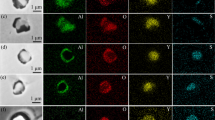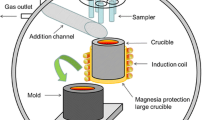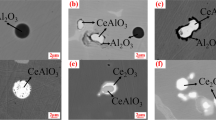Abstract
Previous studies on inclusions behavior at the front of the solidifying steel shell have mainly focused on low-carbon steels. However, with the increasing applications of high-carbon steel in recent years because of its superior properties, it is crucial to understand this behavior in high-carbon steel. Most of the high-carbon steels are deoxidized by silicon, calcium treated, and contain higher sulfur percentage. Also, higher carbon content has a determining influence on the viscosity and surface tension, which will affect the inclusion behavior. In this study, we have investigated the engulfment behaviors of inclusions in front of the solidifying interface in high-carbon steels using concentric solidification method. The critical velocity of the growing shell, at which the particle is engulfed in the solidifying shell, instead of being pushed by this shell, was determined. The inclusion identified in this study is a bi-component form of CaO-SiO2-based oxide and CaS. It was revealed that engulfment behavior is strongly affected by convection of liquid steel that originates from carbon push out in high-carbon steels. This study provides new crucial information to produce high-carbon steel with fewer inclusions, which opens new application pathways for this emerging grade of steel.














Similar content being viewed by others
References
K. Okazawa, A. Kiyose, I. Sawada, T. Toh, and E. Takeuchi, Tetsu-to-Hagané, 1996, vol. 82, pp. 749-753.
U. D. Salgado, S.K. Michelic, and C. Bernhard, Materials science and engineering, 2016, vol. 119, pp. 012003.
S. K. Michelic, U. D. Salgado, and C. Bernhard, Materials science and engineering, 2016, vol. 143, pp. 01201.
Y. Tanaka, F. Pahlevani and V. Sahajwalla, Metal, 2018, vol. 8, pp. 176.
W. Mu, N. Dogan, K. S. Coley, JOM, 2018, vol. 70, pp. 1199-1209.
S. Michelic, J. Goriupp, S. Feichtinger, Y. Kang, C. Bernhard and J. Schenk, Steel Research International, 2016, vol. 87, pp. 57-67.
S. Moon, R. Dippenaar, and S. Kim, AISTech 2015 Proc., AIST, Warrendale, PA, 2015.
S. Moon, R. Dippenaar, and S. Lee, Materials science and engineering, 2011, vol. 27, pp. 012061.
B. Khurana, S. Spooner, M. B. V. Rao, G. G. Roy, P. Srirangam, Metallurgical and Materials Transactions B, 2017, vol. 48, pp. 1409-1415.
N. Yuki, H. Shibata, and T. Emi, ISIJ International, 1998, vol. 38, pp. 317-323.
T. Yoshioka, Y. Shimamura, A. Karasev, Y. Ohba, P.G. Jonsson: in Materials Processing Fundamentals 2018. TMS 2018. The Minerals, Metals & Materials Series, G. Lambotte, J. Lee, A. Allanore, S. Wagstaff, eds., Springer, Cham, 2018.
J. H. Shin, J. H. Park, Metallurgical and Materials Transactions B, 2018, vol. 49, pp. 311-324.
H. Shibata, H. Yin, S. Yoshinaga, T. Emi, and M. Suzuki, ISIJ International, 1998, vol. 38, pp. 149-156.
K. J. Malmberg, H. Shibata, S. Kitamura, P. G. Jonsson, S. Nabeshima, Y. Kishimoto, J Mater Sci., 2010, vol. 45, pp. 2157-2164.
H. Ohta and H. Suito, ISIJ International, 2006, vol. 46, pp. 22-28.
H. Ohta and H. Suito, ISIJ International, 2006, vol. 46, pp. 472-479.
D. M. Stefanescu and A. V. Catalina, ISIJ International, 1998, vol. 38, pp. 503-505.
M. Reid, D. Phelan and R. Dippenaar, ISIJ International, 2004, vol. 44, pp. 565-572.
J. Miettinen and A. A. Howe, Ironmaking and Steelmaking, 2000, vol. 27, pp. 212-227.
Y. Ito, N. Yonezawa and K. Matsubara, Tetsu-to-Hagané, 1979, vol. 65, 391-398.
D. K. Shangguan, S. Ahuja and D. K. Stefanescu, Metall. Trans. A, 1992, vol. 23, pp. 669-680.
K. Ogino, and K. Nogi, Tetsu-to-Hagané, 1973, vol. 59, pp. 1380-1387.
N. Shinozaki, K. Fujiike, K. Mori and K. Kawai, Technol. Rept. Kyushu Univ., 1989, vol. 62, pp. 573.
H. Sun, N. Yoneda, K. Nakashima and K. Mori, Tetsu-to-Hagané, 1997, vol. 83, pp. 1-6.
A.I. Beliaev: Proceedings of an Interinstitute Conference, Consultants Bureau, New York, 1965.
Y. Kawai, K. Mori, M. Kishimoto, K. Ishikura and T. Shimada, Tetsu-to-Hagané, 1974, vol. 60, pp. 29-37.
K. Nakashima and K. Mori, ISIJ international, 1992, vol. 32, pp. 11-18.
K. Kawai, K. Mori, M. Kishimoto, K. Ishikura and T. Shimada, Tetsu-to-Hagané, 1974, vol. 60, pp. 38-44.
M Hansen (1958) Constitution of Binary Alloy. McGraw-Hill, New York, p. 353.
Acknowledgments
This research was financially supported under Australian Research Council’s Industrial Transformation Research Hub funding scheme (Project IH130200025). Y.T. would like to thank Nippon Steel & Sumitomo Metal Corporation, Japan for the scholarship support provided for his Ph.D. study in the UNSW, Sydney. This research used the facilities supported by AMMRF at the Electron Microscope Unit at the UNSW.
Competing interests
The authors declare no competing interests.
Author information
Authors and Affiliations
Corresponding author
Additional information
Manuscript submitted March 12, 2018.
Rights and permissions
About this article
Cite this article
Tanaka, Y., Pahlevani, F., Privat, K. et al. Engulfment Behavior of Inclusions in High-Carbon Steel: Theoretical and Experimental Investigation. Metall Mater Trans B 49, 2986–2997 (2018). https://doi.org/10.1007/s11663-018-1394-5
Received:
Published:
Issue Date:
DOI: https://doi.org/10.1007/s11663-018-1394-5




